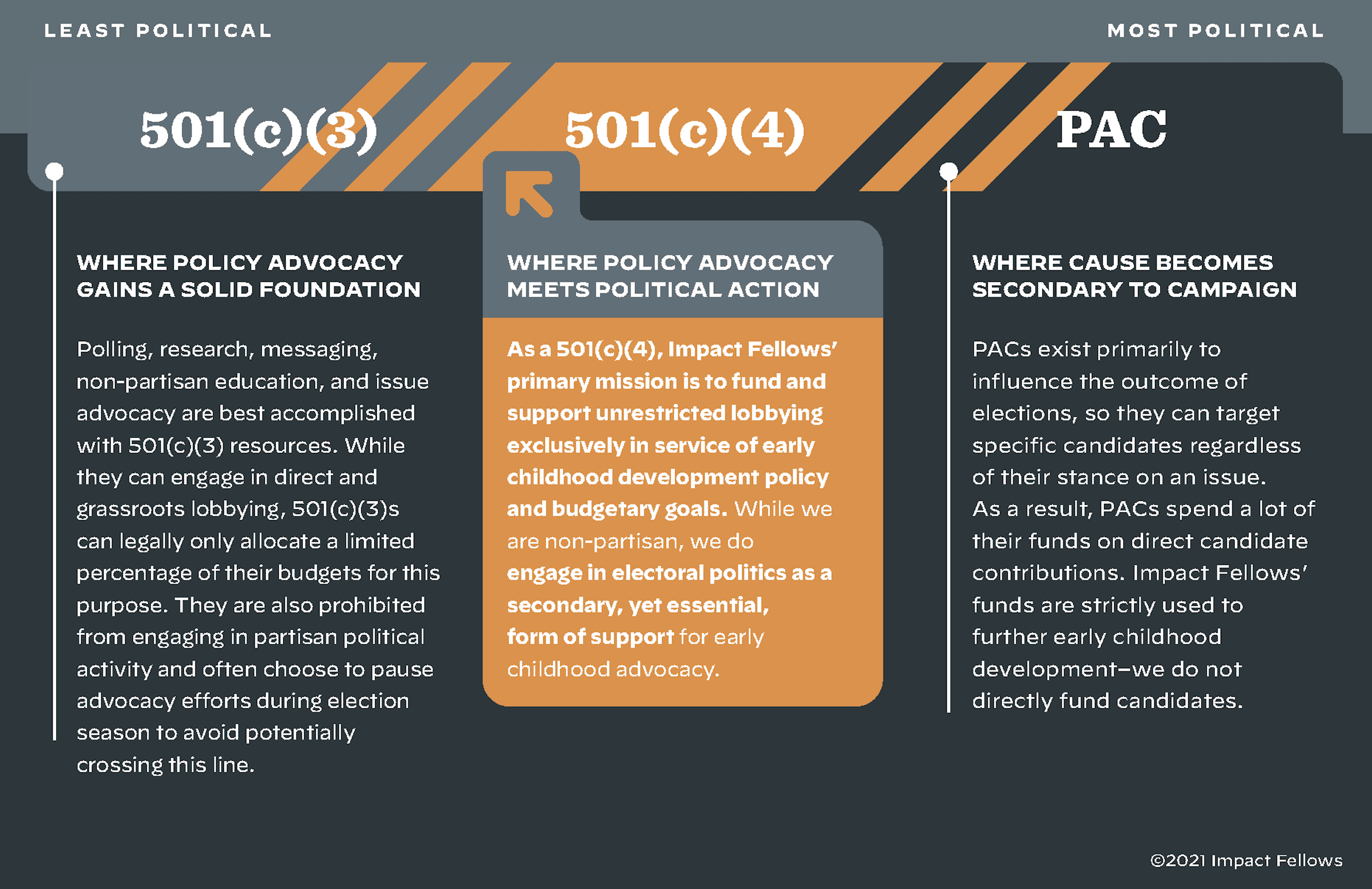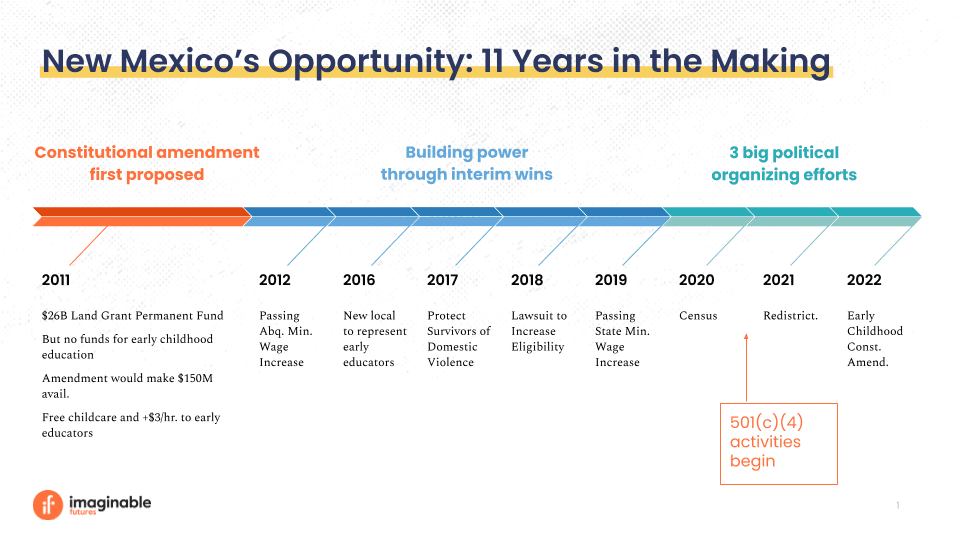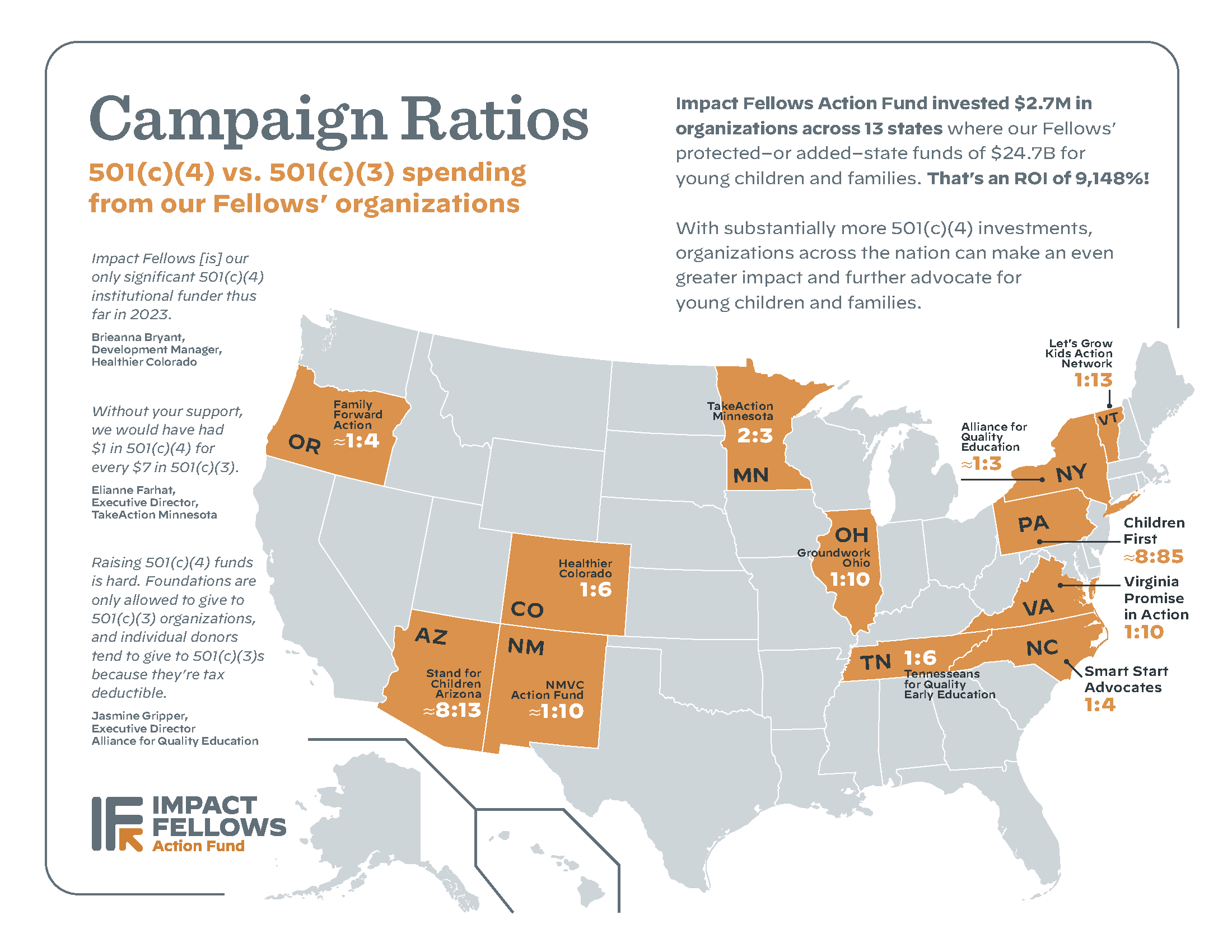United States 
Addressing Early Childhood Education’s Political Problem
3 Ways Funders Can Accelerate Lasting, Equitable Change through 501(c)(4) Investments

United States 
3 Ways Funders Can Accelerate Lasting, Equitable Change through 501(c)(4) Investments

As the last few years have starkly shown, the outcomes of elections matter. Who gets to decide our policy priorities and how they are implemented affects our lives on a daily basis, including the youngest among us. From access to healthy food to availability of safe learning environments, the seeds of a thriving life are planted in early childhood.
While our youngest learners don’t have a vote, they can have a voice. Recent efforts to increase political investment in early childhood movements, especially child care, aim to ensure that the needs of our youngest learners and their caregivers are heard loud and clear by those in positions to shape policy.
Many in philanthropy invest in policy advocacy because they know that shifting policy is fundamental to addressing the systemic issues we focus on – whether it be racial equity, economic mobility, or universal access to quality education and health care. This recognition is what led Imaginable Futures to begin investing in early childhood advocacy. Advocacy can take many forms, as evidenced by the incredible work of our partners who build grassroots power among parents and educators and those who work to shape state-level policy agendas.
Our partners and others in the early childhood movement have effectively built passionate public support and demand for better child care policies, fueled since the pandemic by a greater recognition of child care as a public good. Although inflation ranks among the top issues for voters in 2024, policy inaction at the federal level to invest in child care – the price of which has risen faster than inflation – means that child care costs more than housing in all 50 states.
The cavernous distance between this surging public support and the political will needed for transformative action on child care led a small group of funders – including the Ballmer Group, Heising-Simons Action Fund, and a handful of others – to invest in the political capital of the early childhood movement through 501(c)(4) funding.
If all of this sounds complicated, that’s because it is – figuring out how to understand and navigate these nuances can take time, money, and effort, but accelerating the pace of urgently needed change offers an invaluable return on investment.
While 501(c)(3)s – charitable organizations – and 501(c)(4)s – social welfare organizations – are both not-for-profit, tax-exempt entities, the latter are legally permitted to be more engaged in the political process, with fewer restrictions on influencing legislation and political campaign activities to advance their issues. Importantly, 501(c)(4)s are not political action committees (“PACs”) where the primary political activity may be focused on specific candidates; 501(c)(4) political activity is primarily contained to advocacy for specific issues. In exchange for greater flexibility and power in advancing the issues they care about politically, donors to 501(c)(4)s sacrifice tax deductibility for their contributions. This cheatsheet from Alliance for Justice’s Bolder Advocacy spells out the key differences.
If all of this sounds complicated, that’s because it is – figuring out how to understand and navigate these nuances can take time, money, and effort, but accelerating the pace of urgently needed change offers an invaluable return on investment.
In 2022, we at Imaginable Futures decided to complement the important foundational work of our 501(c)(3) partners with a series of initial 501(c)(4) investments, including for the 2022 Vote Yes for Kids campaign in New Mexico and the Impact Fellows Action Fund, the U.S.’s only multi-state 501(c)(4) intermediary focusing exclusively on early childhood. Our initial learnings affirm the valuable and necessary role of 501(c)(4) investments in creating an early childhood ecosystem that meets the needs of all children, families, and caregivers. Although we and others have since increased our 501(c)(4) investments, the scope of change needed simply requires more resources. This is where other funders focused on early childhood or family well-being can make a meaningful difference in supercharging change for young children.
We are still learning the many ways that political funding supports other advocacy efforts, but here are our top three takeaways for other funders interested in better understanding the role of 501(c)(4) activities in advancing change in early childhood:
“What game can you win if you’re not even on the field?”
Lisa Klein, Impact Fellows Action Fund

“The Point of Impact” from Impact Fellows Action Fund.
We have seen 501(c)(3) work play a pivotal role in identifying problems, innovating with new solutions, advocating for positive change in the early childhood ecosystem, and building power in communities most impacted by the issues we want to address. But, with the U.S. government spending 28 times less on child care than other OECD countries as of late 2021, this work can only do so much without greater public investment. In turn, these public dollars can only be unlocked through legislation and budgeting processes overseen by local, state, and federal politicians who are continuously inundated with competing interest groups seeking their attention.
As Impact Fellows Action Fund founder and president Lisa Klein puts it: “What game can you win if you’re not even on the field?” After years in early childhood philanthropy and traditional advocacy, she launched Impact Fellows in 2020 to fuel 501(c)(4) investments, providing what she sees as the missing piece for winning transformative change in early childhood.
To persuade policymakers to prioritize key issues, the early childhood field must wield tangible political power the way other successful movements have done, connecting a policymaker’s decision to support or dismiss the wellbeing of children and families to their political success. Building this kind of political power requires more flexible capital to ensure champions for early childhood are elected, then held accountable to their promises.
Political power can also help take the issue directly to voters, rather than rely on lawmakers to champion change alone. We saw this power on display in New Mexico in 2022, when the Vote Yes For Kids movement campaigned to remove political bottlenecks to getting Constitutional Amendment 1 (“CA 1”), a proposal to enshrine $150 million of early childhood education into their state constitution, on the ballot. They succeeded, leading to voters overwhelmingly voting in favor of its passage. Importantly, this thrilling victory was built on over a decade of awareness-raising, coalition-building, and organizing – but large-scale 501(c)(4) campaigns were still needed to reach the finish line.
Notably, New Mexico’s triumph came the same year as progress at the national level saw a disappointing setback with the failure of Build Back Better, which included proposals to invest in child care and education. Recognizing the need for more political resources, a new coalition has committed $50 million to electoral advocacy activities in 2024.

“Year-round engagement is how we got to 70% support… Year-round canvassing allowed us to continue engaging, educating, and recruiting supporters after we first IDed them… Only 5.9% of voters didn’t vote on Constitutional Amendment 1, which followed countless judges and other candidates on the ballot.”
Matthew Henderson, OLÉ Education Fund
While it is important to fully celebrate a win that has been a decade in the making, our 501(c)(4) partners taught us that winning is only the beginning. To ensure policies are implemented equitably and support those who stand to gain the most, 501(c)(4) funding must continue into electoral off-years to hold legislators accountable to their promises and to the communities they serve. Stable investment is also critical for maintaining momentum on year-round political activities, including lobbying, canvassing efforts, and the development of effective leaders that can continue the work to push for policy change.
We have also seen how important it is to defend policy gains in the years following victory. Indeed, if an advocacy campaign were to succeed in passing legislation, it should be unsurprising for opposing factions to attempt to claw back those gains before the legislation is fully implemented. Building power takes time and dedicated work, a task that can be made even harder when starting from scratch each election cycle. Advocates must maintain the ability to be a “credible threat” to effectively defend policy gains once they are won and build toward the next win.
“[Constitutional Amendment 1 will provide] $150 million a year for child care. Philanthropy can’t pay for that, but if we help groups on the ground that build the power to make those kinds of changes, we have a more lasting impact than if we just do direct expenditures for child care.”
Rachel Schumacher, Raising Child Care Fund, told Inside Philanthropy on the impact of New Mexico’s ballot initiative win
Consider these figures:
Few social change investments offer this kind of bang for the buck, yet 501(c)(4) funding is woefully hard to come by, particularly for issues related to early childhood. Impact Fellows found their state partners’ available funding for 501(c)(4) activities in 2023 was 6 times less on average than their funding to carry out traditional 501(c)(3) advocacy, representing just 13% of organizational budgets.

Source: Impact Fellows Action Fund
Of course, these incredible financial returns are the result of winning tangible policy gains. We are continuing to learn about the conditions most conducive to success for 501(c)(4) campaigns. So far, we have seen patterns of success in states where there is foundational 501(c)(3) work – those that have built strong coalitions among organizers and advocates; have effective sources and experts that lawmakers trust; and have committed support from local business leaders and funders.
Perhaps the greatest lesson we learned from our foray into 501(c)(4) funding is that our work – systems change work – will always be political, as the changes we wish to see in early childhood education will require significantly more public investment, which requires the field to convince lawmakers to prioritize child care among a sea of competing issues. As we continue to be on our 501(c)(4) learning journey, we encourage other funders to join and share lessons learned with each other. We can collectively amplify our funding’s impact by unlocking public dollars in places where advocates have already worked tirelessly for change. As funders, we must be open to learning, shifting and giving our partners greater access to the power that they need to win for children and families.
A presidential election year often brings revived attention to who gets to decide the direction of our national priorities. But as we are learning through our 501(c)(4) investments, the work that ensures an equitable, thriving future for our youngest learners is an ongoing, multi-year process that requires funders to take a stand.
If you are a funder and interested in learning alongside us, please get in touch at hello@imaginablefutures.com.
Header photo: advocates from Vote Yes for Kids celebrate the passage of New Mexico’s Constitutional Amendment 1. (Photo courtesy of Vote Yes for Kids.)
Few social change investments offer this kind of bang for the buck, yet 501(c)(4) funding is woefully hard to come by, particularly for issues related to early childhood.